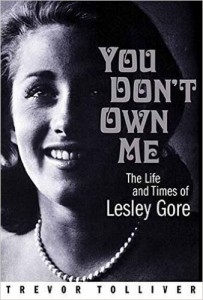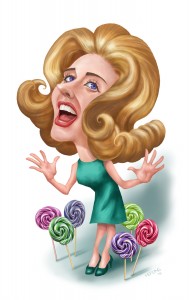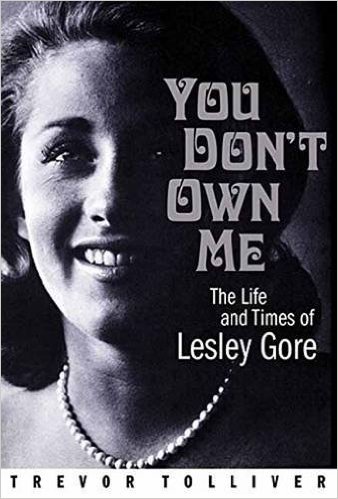 You Don’t Own Me
You Don’t Own Me
by Trevor Tolliver
Backbeat Books. 209 pages, $24.99
BORN JUST AFTER World War II, the late Lesley Gore (1946–2015) was, according to her parents, a musical prodigy. They claimed that she could vocally “duplicate the melody of a song” at the age of six months. As a toddler, she loved to perform for her parents’ guests. In recounting those anecdotes and others that follow, Tolliver seems as proud as any parent or uncle. This can sometimes lead to a somewhat uncomfortable tone of familiarity, but otherwise the author does a decent job recounting Gore’s career trajectory—and what an astounding career it was, especially from the point-of-view of today.
Lesley Gore was born in Brooklyn into an upwardly mobile Jewish family, which soon moved to Tenafly, New Jersey, where she attended high school at the Dwight School for Girls. In middle school she had joined a girl group; by high school, where she sang in the chorus, her talent as a singer was apparent. She begged her parents for a vocal coach. They hired one, and he was impressed enough to take Gore to a music studio, where she recorded a small number of songs to pass around to her family. A cousin gave one of these records to a bandleader, who invited Gore to perform at a gig where the president of Mercury Records was seated in the audience. In early 1963, that executive gave Gore’s demo to music producer Quincy Jones, and around two months later, at age sixteen, Lesley Gore was a bona fide star. Her first song, “It’s My Party,” rocketed to number one on the Billboard chart.
 There followed in rapid succession a few more hits that made the Top Ten—“Judy’s Turn to Cry,” “She’s a Fool” (both 1963), and “You Don’t Own Me” (1964); a few more lesser hits, including the treacly “Sunshine, Lollipops, and Rainbows” (1965) by Marvin Hamlisch, and then…. Her career became shaky almost immediately, a fact that Tolliver attributes to the wild popularity of the Beatles and the British Invasion that landed on our shores right at the peak of Gore’s popularity. She continued touring and recording, though on these fronts her star had faded. She even had an acting career, appearing in two episodes of Batman (as Catwoman’s sidekick) in 1967. But her major accomplishments after 1970 were in movie songwriting, which she carried out in collaboration with her brother Michael; a song on their soundtrack for 1980’s Fame garnered an Oscar nomination. To be sure, she never again achieved the kind of success she had known at age sixteen.
There followed in rapid succession a few more hits that made the Top Ten—“Judy’s Turn to Cry,” “She’s a Fool” (both 1963), and “You Don’t Own Me” (1964); a few more lesser hits, including the treacly “Sunshine, Lollipops, and Rainbows” (1965) by Marvin Hamlisch, and then…. Her career became shaky almost immediately, a fact that Tolliver attributes to the wild popularity of the Beatles and the British Invasion that landed on our shores right at the peak of Gore’s popularity. She continued touring and recording, though on these fronts her star had faded. She even had an acting career, appearing in two episodes of Batman (as Catwoman’s sidekick) in 1967. But her major accomplishments after 1970 were in movie songwriting, which she carried out in collaboration with her brother Michael; a song on their soundtrack for 1980’s Fame garnered an Oscar nomination. To be sure, she never again achieved the kind of success she had known at age sixteen.
Personally, as Tolliver writes, while she sang about young love and boys, Gore knew as a teen that she was a lesbian. She didn’t dare to come out to her family, much less to her fans, knowing full well that it would have meant an end to her career. For that reason, the details of Gore’s sexual and affectional feelings during this period are not well documented. It was only in 2005 that she came out publicly (on the TV show After Ellen), though she was in a fully functioning lesbian relationship, and had been for 33 years, at that time.
Unfortunately, this aspect of Gore’s life, or indeed her personal history in general, takes up only a small fraction of Tolliver’s biography, which focuses much more on her discography, movie career, concert tours, and professional life. What’s more, all of this insider information is presented in the breathless, star-struck tone of a supermarket tabloid—or perhaps a Confessions magazine, circa 1963. Ardent fans of Lesley Gore may share this level of enthusiasm for the minutiæ of her recording career, but I suspect not everyone will.
Terri Schlichenmeyer is a freelance writer who lives in LaCrosse, Wisconsin.







Discussion1 Comment
Leslie gore was a great singer. You don’t own me , California nights , it’s my party all great songs.